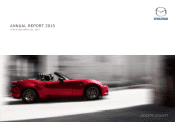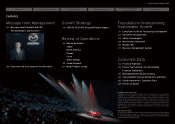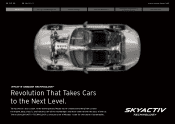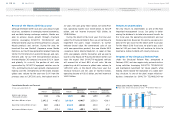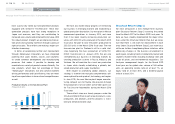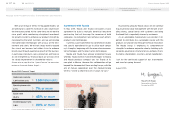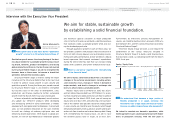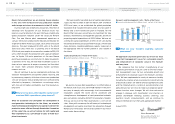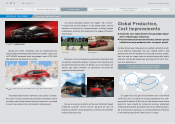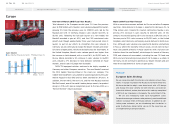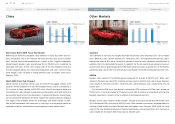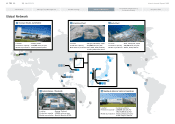Mazda 2015 Annual Report Download - page 11
Download and view the complete annual report
Please find page 11 of the 2015 Mazda annual report below. You can navigate through the pages in the report by either clicking on the pages listed below, or by using the keyword search tool below to find specific information within the annual report.
Mexico fully operational, we are making steady progress
in this area with increased overseas production volume
and stronger resistance to movements in the U.S. dollar.
Due to a high ratio of domestic production, the effect of
exchange rate fluctuations on our financial results has
been an issue for Mazda in the past. We have established a
global production footprint under the Structural Reform
Plan. The new Mexico plant commenced operations in
January 2014 and is producing the Mazda3 and Mazda2 for
shipment to North America, Europe, and Central and South
America. The plant produced 140,000 units in the March
2015 fiscal year, which was as planned, and in the March
2016 fiscal year we plan to increase this number to 230,000
units, which includes the production and supply of compact
cars to Toyota. Full-scale operations at the new Mexico
plant have reduced our sensitivity to U.S. dollar movements
as planned. In this way, we have had reasonable success in
terms of our exposure to major currencies, but the effect
on results from unstable emerging market currencies
remains an issue.
We will continue to pursue appropriate exchange rate
exposure management and optimal global sourcing, and
by maximizing capacity utilization at overseas production
sites we will quickly reduce production costs without being
affected by temporary fluctuations in exchange rates,
with the aim of higher profitability over the medium-to-
long term.
Q4 What are your plans with regard to capital invest-
ment and R&D expenditures going forward?
While we accelerate and strengthen the development of
next-generation technologies for the future, we intend to
make technological development and capital investment for
production more efficient through Monotsukuri Innovation.
At the same time, we will set ceilings for both capital and
R&D expenditures as a percentage of sales to make disci-
plined investments.
We have recently had a high level of capital expenditures,
surpassing ¥130.0 billion in both the March 2014 and March
2015 fiscal years, as we established the global production
foundation that included the construction of a new plant in
Mexico and a new transmission plant in Thailand. For the
March 2016 fiscal year, we will focus on investment for new
products, maintenance, and equipment upgrades, and we are
projecting capital expenditures of ¥105.0 billion. We have set
a ceiling for capital expenditures of 3.5% of net sales during
the period covered by Structural Reform Stage 2. We will also
make decisions regarding additional capacity expansion at
the appropriate time for further growth in sales volume in
the future.
We plan to increase R&D expenditures to ¥125.0 billion in
the March 2016 fiscal year, from ¥108.4 billion in the previ-
ous year, to comply with increasingly strict environmental
regulations around the world and to accelerate and
strengthen our development of next-generation technolo-
gies and vehicles, including SKYACTIV Generation 2 models.
The cap we have set for R&D expenditures is 4.0% of net
sales. Along with increasing the efficiency of technological
development and capital investment for production through
Monotsukuri Innovation, we will be disciplined in our invest-
ment under these ceilings.
Q5 What are your thoughts regarding corporate
governance?
We approach corporate governance as one of our most
important management issues for sustainable growth
and enhancement of corporate value in the medium-
and long-term.
We recognize that the further strengthening of our
corporate governance structure is one of the most impor-
tant management issues for our sustainable growth and
enhancement of corporate value in the medium- and long-
term. We have implemented a variety of measures to date,
including the creation of an environment in which full-time
and outside auditors are able to conduct appropriate audits
and the introduction of a system of outside directors, but
going forward we will strive to make our corporate gover-
nance structure even stronger. We will also continue to
engage in dialogue with shareholders and investors at
general shareholder meetings, business briefings, and
quarterly results announcements, and we continue to
release information in a timely and appropriate manner.
August 2015
Akira Marumoto
Representative Director and
Executive Vice President
Interview with the Executive Vice President
Capital Expenditures / Ratio of Net Sales
■ Capital Expenditures (Billions of yen) Ratio of Net Sales (%)
(Forecast)
(Forecast)
3.8 4.9
3.5 4.3 3.2
78.0
2012 2013 2014 20162015 2017~
2019
77.2
133.2 131.0
105.0
Research and Development Costs / Ratio of Net Sales
■
Research and Development Costs (Billions of yen) Ratio of Net Sales (%)
(Forecast)
(Forecast)
4.5 3.7
4.1 3.6 3.8
91.7 89.9 99.4 108.4 125.0
2012 2013 2014 20162015 2017~
2019
(Years ended March 31)
(Years ended March 31)
Mazda Annual Report 2015
09
Message from Management
CONTENTS
Foundations Underpinning
Sustainable Growth
Growth Strategy
Introduction
Review of Operations
Corporate Data

